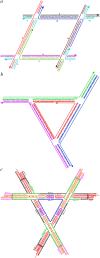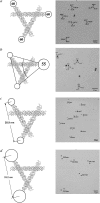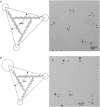Metallic nanoparticles used to estimate the structural integrity of DNA motifs
- PMID: 18621817
- PMCID: PMC2547441
- DOI: 10.1529/biophysj.108.138479
Metallic nanoparticles used to estimate the structural integrity of DNA motifs
Abstract
Branched DNA motifs can be designed to assume a variety of shapes and structures. These structures can be characterized by numerous solution techniques; the structures also can be inferred from atomic force microscopy of two-dimensional periodic arrays that the motifs form via cohesive interactions. Examples of these motifs are the DNA parallelogram, the bulged-junction DNA triangle, and the three-dimensional-double crossover (3D-DX) DNA triangle. The ability of these motifs to withstand stresses without changing geometrical structure is clearly of interest if the motif is to be used in nanomechanical devices or to organize other large chemical species. Metallic nanoparticles can be attached to DNA motifs, and the arrangement of these particles can be established by transmission electron microscopy. We have attached 5 nm or 10 nm gold nanoparticles to every vertex of DNA parallelograms, to two or three vertices of 3D-DX DNA triangle motifs, and to every vertex of bulged-junction DNA triangles. We demonstrate by transmission electron microscopy that the DNA parallelogram motif and the bulged-junction DNA triangle are deformed by the presence of the gold nanoparticles, whereas the structure of the 3D-DX DNA triangle motif appears to be minimally distorted. This method provides a way to estimate the robustness and potential utility of the many new DNA motifs that are becoming available.
Figures






Similar articles
-
Biochemistry and structural DNA nanotechnology: an evolving symbiotic relationship.Biochemistry. 2003 Jun 24;42(24):7259-69. doi: 10.1021/bi030079v. Biochemistry. 2003. PMID: 12809482
-
Alignment of gold clusters on DNA via a DNA-recognizing zinc finger-metallothionein fusion protein.Bioconjug Chem. 2009 Dec;20(12):2278-85. doi: 10.1021/bc9002713. Bioconjug Chem. 2009. PMID: 19938825
-
The absence of tertiary interactions in a self-assembled DNA crystal structure.J Mol Recognit. 2012 Apr;25(4):234-7. doi: 10.1002/jmr.2183. J Mol Recognit. 2012. PMID: 22434713 Free PMC article.
-
At the crossroads of chemistry, biology, and materials: structural DNA nanotechnology.Chem Biol. 2003 Dec;10(12):1151-9. doi: 10.1016/j.chembiol.2003.12.002. Chem Biol. 2003. PMID: 14700623 Review.
-
Dispersions based on noble metal nanoparticles-DNA conjugates.Adv Colloid Interface Sci. 2011 Apr 14;163(2):123-43. doi: 10.1016/j.cis.2011.02.007. Epub 2011 Feb 19. Adv Colloid Interface Sci. 2011. PMID: 21382609 Review.
Cited by
-
DNA-Driven Dynamic Assembly/Disassembly of Inorganic Nanocrystals for Biomedical Imaging.Chem Biomed Imaging. 2023 May 8;1(4):340-355. doi: 10.1021/cbmi.3c00028. eCollection 2023 Jul 24. Chem Biomed Imaging. 2023. PMID: 37501793 Free PMC article. Review.
-
A modular approach for assembling aldehyde-tagged proteins on DNA scaffolds.J Am Chem Soc. 2014 Aug 6;136(31):10850-3. doi: 10.1021/ja504711n. Epub 2014 Jul 25. J Am Chem Soc. 2014. PMID: 25029632 Free PMC article.
References
-
- Chen, J., and N. C. Seeman. 1991. The synthesis from DNA of a molecule with the connectivity of a cube. Nature. 350:631–633. - PubMed
-
- Winfree, E., F. Liu, L. A. Wenzler, and N. C. Seeman. 1998. Design and self-assembly of two-dimensional DNA crystals. Nature. 394:539–544. - PubMed
-
- Mao, C., W. Sun, Z. Shen, and N. C. Seeman. 1999. A DNA nanomechanical device based on the B-Z transition. Nature. 397:144–146. - PubMed
-
- Yan, H., X. Zhang, Z. Shen, and N. C. Seeman. 2002. A robust DNA mechanical device controlled by hybridization topology. Nature. 415:62–65. - PubMed
Publication types
MeSH terms
Substances
Grants and funding
LinkOut - more resources
Full Text Sources
Other Literature Sources

